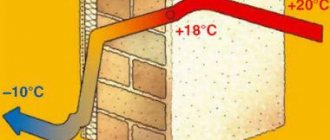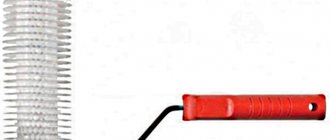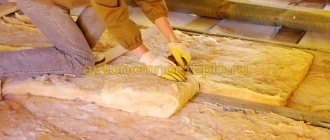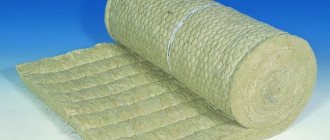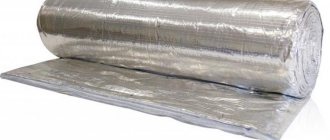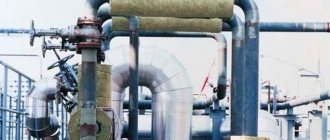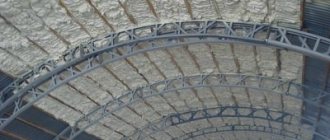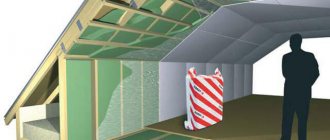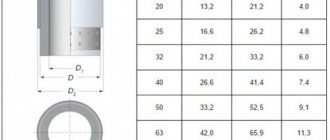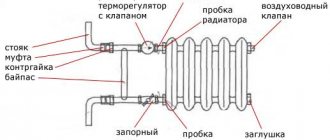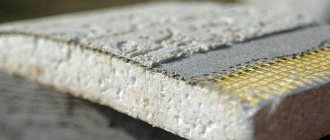Thermal conductivity of building materials, their density and heat capacity
An extensive table of thermal conductivity of building materials, as well as density and specific heat capacity of materials in a dry state at atmospheric pressure and a temperature of 20 ... 50 ° C (unless another temperature is indicated) is given. Values given for over 400 materials!
Attention should be paid to the value of thermal conductivity of building materials in the table, since this characteristic, along with their density, is the most important. Especially thermal conductivity is important for building materials used as thermal insulation for thermal insulation of building structures.
The thermal conductivity of building materials significantly depends on their porosity and density. The lower the density, the lower the thermal conductivity of the material., therefore, low thermal conductivity is characteristic of porous and light materials (you can also find the density values of building materials, metals and alloys, products and other substances in the detailed density table).
For example, in our table of thermal conductivity of materials and heaters, the following building materials with a low coefficient of thermal conductivity can be distinguished - this is airgel (from 0.014 W / (m deg)), glass wool, expanded polystyrene foam and expanded rubber (from 0.03 W / (m · deg)), MBOR insulation (from 0.038 W / (m · deg)), aerated concrete and foam concrete (from 0.08 W / (m · deg)).
Thermal conductivity of building materials - table
| Material | Density, kg / m3 | Thermal conductivity, W / (m · deg) | Heat capacity, J / (kg deg) |
| ABS (ABS plastic) | 1030…1060 | 0.13…0.22 | 1300…2300 |
| Agloporite concrete and concrete on fuel (boiler) slags | 1000…1800 | 0.29…0.7 | 840 |
| Acrylic (acrylic glass, polymethyl methacrylate, plexiglass) GOST 17622-72 | 1100…1200 | 0.21 | — |
| Alfol | 20…40 | 0.118…0.135 | — |
| Aluminum (GOST 22233-83) | 2600 | 221 | 897 |
| Fibrous asbestos | 470 | 0.16 | 1050 |
| Asbestos cement | 1500…1900 | 1.76 | 1500 |
| Asbestos cement sheet | 1600 | 0.4 | 1500 |
| Asbozurite | 400…650 | 0.14…0.19 | — |
| Asbestos | 450…620 | 0.13…0.15 | — |
| Asbotextolite G (GOST 5-78) | 1500…1700 | — | 1670 |
| Asbothermite | 500 | 0.116…0.14 | — |
| Asbestos slurry with a high asbestos content | 1800 | 0.17…0.35 | — |
| Asboschifer with 10-50% asbestos | 1800 | 0.64…0.52 | — |
| Felt asbestos cement | 144 | 0.078 | — |
| Asphalt | 1100…2110 | 0.7 | 1700…2100 |
| Asphalt concrete (GOST 9128-84) | 2100 | 1.05 | 1680 |
| Asphalt in the floors | — | 0.8 | — |
| Acetal (polyacetal, polyformaldehyde) POM | 1400 | 0.22 | — |
| Airgel (Aspen aerogels) | 110…200 | 0.014…0.021 | 700 |
| Basalt | 2600…3000 | 3.5 | 850 |
| Bakelite | 1250 | 0.23 | — |
| Balsa | 110…140 | 0.043…0.052 | — |
| Birch | 510…770 | 0.15 | 1250 |
| Lightweight concrete with natural pumice | 500…1200 | 0.15…0.44 | — |
| Concrete on gravel or crushed stone from natural stone | 2400 | 1.51 | 840 |
| Volcanic slag concrete | 800…1600 | 0.2…0.52 | 840 |
| Blast-furnace granulated slag concrete | 1200…1800 | 0.35…0.58 | 840 |
| Ash gravel concrete | 1000…1400 | 0.24…0.47 | 840 |
| Concrete on crushed stone | 2200…2500 | 0.9…1.5 | — |
| Boiler slag concrete | 1400 | 0.56 | 880 |
| Concrete on the sand | 1800…2500 | 0.7 | 710 |
| Fuel slag concrete | 1000…1800 | 0.3…0.7 | 840 |
| Dense silicate concrete | 1800 | 0.81 | 880 |
| Solid concrete | — | 1.75 | — |
| Insulating concrete | 500 | 0.18 | — |
| Bitumen perlite | 300…400 | 0.09…0.12 | 1130 |
| Petroleum bitumens for construction and roofing (GOST 6617-76, GOST 9548-74) | 1000…1400 | 0.17…0.27 | 1680 |
| Aerated concrete block | 400…800 | 0.15…0.3 | — |
| Porous ceramic block | — | 0.2 | — |
| Bronze | 7500…9300 | 22…105 | 400 |
| Paper | 700…1150 | 0.14 | 1090…1500 |
| Booth | 1800…2000 | 0.73…0.98 | — |
| Light mineral wool | 50 | 0.045 | 920 |
| Heavy mineral wool | 100…150 | 0.055 | 920 |
| Glass wool | 155…200 | 0.03 | 800 |
| Cotton wool | 30…100 | 0.042…0.049 | — |
| Cotton wool | 50…80 | 0.042 | 1700 |
| Slag cotton wool | 200 | 0.05 | 750 |
| Vermiculite (in the form of bulk granules) GOST 12865-67 | 100…200 | 0.064…0.076 | 840 |
| Expanded vermiculite (GOST 12865-67) - backfill | 100…200 | 0.064…0.074 | 840 |
| Vermiculite concrete | 300…800 | 0.08…0.21 | 840 |
| Air dry at 20 ° C | 1.205 | 0.0259 | 1005 |
| Woolen felt | 150…330 | 0.045…0.052 | 1700 |
| Gas and foam concrete, gas and foam silicate | 280…1000 | 0.07…0.21 | 840 |
| Gas and foam ash concrete | 800…1200 | 0.17…0.29 | 840 |
| Getinax | 1350 | 0.23 | 1400 |
| Dry molded gypsum | 1100…1800 | 0.43 | 1050 |
| Drywall | 500…900 | 0.12…0.2 | 950 |
| Gypsum perlite solution | — | 0.14 | — |
| Gypsum slag | 1000…1300 | 0.26…0.36 | — |
| Clay | 1600…2900 | 0.7…0.9 | 750 |
| Refractory clay | 1800 | 1.04 | 800 |
| Clay gypsum | 800…1800 | 0.25…0.65 | — |
| Alumina | 3100…3900 | 2.33 | 700…840 |
| Gneiss (cladding) | 2800 | 3.5 | 880 |
| Gravel (filler) | 1850 | 0.4…0.93 | 850 |
| Expanded clay gravel (GOST 9759-83) - backfill | 200…800 | 0.1…0.18 | 840 |
| Shungizite gravel (GOST 19345-83) - backfill | 400…800 | 0.11…0.16 | 840 |
| Granite (cladding) | 2600…3000 | 3.5 | 880 |
| Soil 10% water | — | 1.75 | — |
| Soil 20% water | 1700 | 2.1 | — |
| Sandy soil | — | 1.16 | 900 |
| The soil is dry | 1500 | 0.4 | 850 |
| Compacted soil | — | 1.05 | — |
| Tar | 950…1030 | 0.3 | — |
| Dolomite dense dry | 2800 | 1.7 | — |
| Oak along the grain | 700 | 0.23 | 2300 |
| Oak across the grain (GOST 9462-71, GOST 2695-83) | 700 | 0.1 | 2300 |
| Duralumin | 2700…2800 | 120…170 | 920 |
| Iron | 7870 | 70…80 | 450 |
| Reinforced concrete | 2500 | 1.7 | 840 |
| Reinforced concrete rammed | 2400 | 1.55 | 840 |
| Wood ash | 780 | 0.15 | 750 |
| Gold | 19320 | 318 | 129 |
| Limestone (cladding) | 1400…2000 | 0.5…0.93 | 850…920 |
| Products made of expanded perlite on a bituminous binder (GOST 16136-80) | 300…400 | 0.067…0.11 | 1680 |
| Vulcanite products | 350…400 | 0.12 | — |
| Diatomite products | 500…600 | 0.17…0.2 | — |
| Newvelite products | 160…370 | 0.11 | — |
| Foam concrete products | 400…500 | 0.19…0.22 | — |
| Perlitophosphogel products | 200…300 | 0.064…0.076 | — |
| Sovelite products | 230…450 | 0.12…0.14 | — |
| Frost | — | 0.47 | — |
| Yporka (foamed resin) | 15 | 0.038 | — |
| Coal dust | 730 | 0.12 | — |
| Porous ceramic stone Braer 14.3 NF and 10.7 NF | 810…840 | 0.14…0.185 | — |
| Hollow-core stones from lightweight concrete | 500…1200 | 0.29…0.6 | — |
| Solid stones from lightweight concrete DIN 18152 | 500…2000 | 0.32…0.99 | — |
| Solid stones of natural tuff or expanded clay | 500…2000 | 0.29…0.99 | — |
| Building stone | 2200 | 1.4 | 920 |
| Black carbolite | 1100 | 0.23 | 1900 |
| Insulating asbestos cardboard | 720…900 | 0.11…0.21 | — |
| Corrugated cardboard | 700 | 0.06…0.07 | 1150 |
| Facing cardboard | 1000 | 0.18 | 2300 |
| Waxed cardboard | — | 0.075 | — |
| Thick cardboard | 600…900 | 0.1…0.23 | 1200 |
| Corkboard | 145 | 0.042 | — |
| Construction multilayer cardboard (GOST 4408-75) | 650 | 0.13 | 2390 |
| Thermal insulating cardboard (GOST 20376-74) | 500 | 0.04…0.06 | — |
| Foamed rubber | 82 | 0.033 | — |
| Vulcanized hard rubber, gray | — | 0.23 | — |
| Vulcanized rubber soft gray | 920 | 0.184 | — |
| Natural rubber | 910 | 0.18 | 1400 |
| Hard rubber | — | 0.16 | — |
| Fluorinated rubber | 180 | 0.055…0.06 | — |
| Red cedar | 500…570 | 0.095 | — |
| Lacquered cambric | — | 0.16 | — |
| Expanded clay | 800…1000 | 0.16…0.2 | 750 |
| Expanded clay peas | 900…1500 | 0.17…0.32 | 750 |
| Expanded clay concrete on quartz sand with porization | 800…1200 | 0.23…0.41 | 840 |
| Lightweight expanded clay | 500…1200 | 0.18…0.46 | — |
| Expanded clay concrete on expanded clay sand and expanded clay foam concrete | 500…1800 | 0.14…0.66 | 840 |
| Expanded clay concrete on perlite sand | 800…1000 | 0.22…0.28 | 840 |
| Ceramics | 1700…2300 | 1.5 | — |
| Warm ceramics | — | 0.12 | — |
| Blast furnace brick (refractory) | 1000…2000 | 0.5…0.8 | — |
| Diatom brick | 500 | 0.8 | — |
| Insulating brick | — | 0.14 | — |
| Carborundum brick | 1000…1300 | 11…18 | 700 |
| Red dense brick | 1700…2100 | 0.67 | 840…880 |
| Red porous brick | 1500 | 0.44 | — |
| Clinker bricks | 1800…2000 | 0.8…1.6 | — |
| Silica bricks | — | 0.15 | — |
| Facing brick | 1800 | 0.93 | 880 |
| Hollow brick | — | 0.44 | — |
| Silicate brick | 1000…2200 | 0.5…1.3 | 750…840 |
| Silicate brick from those. voids | — | 0.7 | — |
| Slotted silicate brick | — | 0.4 | — |
| Solid brick | — | 0.67 | — |
| Building brick | 800…1500 | 0.23…0.3 | 800 |
| Trellis brick | 700…1300 | 0.27 | 710 |
| Slag brick | 1100…1400 | 0.58 | — |
| Rubble masonry of medium-density stones | 2000 | 1.35 | 880 |
| Gas silicate masonry | 630…820 | 0.26…0.34 | 880 |
| Masonry made of gas silicate thermal insulation boards | 540 | 0.24 | 880 |
| Ordinary clay brickwork on cement-perlite mortar | 1600 | 0.47 | 880 |
| Ordinary clay brickwork (GOST 530-80) on cement-sand mortar | 1800 | 0.56 | 880 |
| Masonry from clay ordinary bricks on cement-slag mortar | 1700 | 0.52 | 880 |
| Ceramic hollow brick masonry on cement-sand mortar | 1000…1400 | 0.35…0.47 | 880 |
| Small brick masonry | 1730 | 0.8 | 880 |
| Hollow wall block masonry | 1220…1460 | 0.5…0.65 | 880 |
| Masonry of silicate 11 hollow bricks on cement-sand mortar | 1500 | 0.64 | 880 |
| Masonry from silicate 14 hollow bricks on cement-sand mortar | 1400 | 0.52 | 880 |
| Sand-lime brick masonry (GOST 379-79) on cement-sand mortar | 1800 | 0.7 | 880 |
| Tripoli brick masonry (GOST 648-73) on cement-sand mortar | 1000…1200 | 0.29…0.35 | 880 |
| Cellular brick masonry | 1300 | 0.5 | 880 |
| Slag brick masonry on cement-sand mortar | 1500 | 0.52 | 880 |
| Masonry "Poroton" | 800 | 0.31 | 900 |
| Maple | 620…750 | 0.19 | — |
| Leather | 800…1000 | 0.14…0.16 | — |
| Technical composites | — | 0.3…2 | — |
| Oil paint (enamel) | 1030…2045 | 0.18…0.4 | 650…2000 |
| Silicon | 2000…2330 | 148 | 714 |
| Organosilicon polymer KM-9 | 1160 | 0.2 | 1150 |
| Brass | 8100…8850 | 70…120 | 400 |
| Ice -60 ° С | 924 | 2.91 | 1700 |
| Ice -20 ° С | 920 | 2.44 | 1950 |
| Ice 0 ° C | 917 | 2.21 | 2150 |
| Multilayer polyvinyl chloride linoleum (GOST 14632-79) | 1600…1800 | 0.33…0.38 | 1470 |
| Polyvinyl chloride linoleum on a fabric backing (GOST 7251-77) | 1400…1800 | 0.23…0.35 | 1470 |
| Linden, (15% moisture) | 320…650 | 0.15 | — |
| Larch | 670 | 0.13 | — |
| Asbestos-cement flat sheets (GOST 18124-75) | 1600…1800 | 0.23…0.35 | 840 |
| Vermiculite sheets | — | 0.1 | — |
| Sheets gypsum cladding (dry plaster) GOST 6266 | 800 | 0.15 | 840 |
| Light cork sheets | 220 | 0.035 | — |
| Heavy cork sheets | 260 | 0.05 | — |
| Magnesia in the form of segments for pipe insulation | 220…300 | 0.073…0.084 | — |
| Asphalt mastic | 2000 | 0.7 | — |
| Mats, basalt canvases | 25…80 | 0.03…0.04 | — |
| Wired glass fiber mats and strips (TU 21-23-72-75) | 150 | 0.061 | 840 |
| Mineral wool stitched mats (GOST 21880-76) and synthetic binder (GOST 9573-82) | 50…125 | 0.048…0.056 | 840 |
| MBOR-5, MBOR-5F, MBOR-S-5, MBOR-S2-5, MBOR-B-5 (TU 5769-003-48588528-00) | 100…150 | 0.045 | — |
| a piece of chalk | 1800…2800 | 0.8…2.2 | 800…880 |
| Copper (GOST 859-78) | 8500 | 407 | 420 |
| Mikanite | 2000…2200 | 0.21…0.41 | 250 |
| Mipora | 16…20 | 0.041 | 1420 |
| Morozin | 100…400 | 0.048…0.084 | — |
| Marble (cladding) | 2800 | 2.9 | 880 |
| Boiler room scale (rich in lime, at 100 ° C) | 1000…2500 | 0.15…2.3 | — |
| Boiler room scale (rich in silicate, at 100 ° C) | 300…1200 | 0.08…0.23 | — |
| Deck flooring | 630 | 0.21 | 1100 |
| Nylon | — | 0.53 | — |
| Nylon | 1300 | 0.17…0.24 | 1600 |
| Neoprene | — | 0.21 | 1700 |
| Wood sawdust | 200…400 | 0.07…0.093 | — |
| Tow | 150 | 0.05 | 2300 |
| Wall panels made of gypsum DIN 1863 | 600…900 | 0.29…0.41 | — |
| Paraffin | 870…920 | 0.27 | — |
| Oak parquet | 1800 | 0.42 | 1100 |
| Piece parquet | 1150 | 0.23 | 880 |
| Panel parquet | 700 | 0.17 | 880 |
| Pumice | 400…700 | 0.11…0.16 | — |
| Pumice concrete | 800…1600 | 0.19…0.52 | 840 |
| Foam concrete | 300…1250 | 0.12…0.35 | 840 |
| Penogypsum | 300…600 | 0.1…0.15 | — |
| Foam ash concrete | 800…1200 | 0.17…0.29 | — |
| Polyfoam PS-1 | 100 | 0.037 | — |
| Polyfoam PS-4 | 70 | 0.04 | — |
| Polyfoam PVC-1 (TU 6-05-1179-75) and PV-1 (TU 6-05-1158-78) | 65…125 | 0.031…0.052 | 1260 |
| Polyfoam resopen FRP-1 | 65…110 | 0.041…0.043 | — |
| Expanded polystyrene (GOST 15588-70) | 40 | 0.038 | 1340 |
| Expanded polystyrene (TU 6-05-11-78-78) | 100…150 | 0.041…0.05 | 1340 |
| Expanded polystyrene Penoplex | 22…47 | 0.03…0.036 | 1600 |
| Polyurethane foam (TU V-56-70, TU 67-98-75, TU 67-87-75) | 40…80 | 0.029…0.041 | 1470 |
| Polyurethane foam sheets | 150 | 0.035…0.04 | — |
| Polyethylene foam | — | 0.035…0.05 | — |
| Polyurethane foam panels | — | 0.025 | — |
| Penosilicalcite | 400…1200 | 0.122…0.32 | — |
| Light foam glass | 100..200 | 0.045…0.07 | — |
| Foam glass or gas glass (TU 21-BSSR-86-73) | 200…400 | 0.07…0.11 | 840 |
| Penofol | 44…74 | 0.037…0.039 | — |
| Parchment | — | 0.071 | — |
| Glassine (GOST 2697-83) | 600 | 0.17 | 1680 |
| Reinforcing ceramic overlap with concrete filling without plaster | 1100…1300 | 0.7 | 850 |
| Ceiling made of reinforced concrete elements with plaster | 1550 | 1.2 | 860 |
| Slab monolithic flat reinforced concrete | 2400 | 1.55 | 840 |
| Perlite | 200 | 0.05 | — |
| Expanded perlite | 100 | 0.06 | — |
| Perlite concrete | 600…1200 | 0.12…0.29 | 840 |
| Perlitoplast-concrete (TU 480-1-145-74) | 100…200 | 0.035…0.041 | 1050 |
| Perlitophosphogel products (GOST 21500-76) | 200…300 | 0.064…0.076 | 1050 |
| Sand 0% moisture | 1500 | 0.33 | 800 |
| Sand 10% moisture | — | 0.97 | — |
| Sand 20% moisture | — | 1.33 | — |
| Sand for construction works (GOST 8736-77) | 1600 | 0.35 | 840 |
| Small river sand | 1500 | 0.3…0.35 | 700…840 |
| River sand fine (wet) | 1650 | 1.13 | 2090 |
| Burnt sandstone | 1900…2700 | 1.5 | — |
| Fir | 450…550 | 0.1…0.26 | 2700 |
| Pressed paper plate | 600 | 0.07 | — |
| Cork slab | 80…500 | 0.043…0.055 | 1850 |
| Refractory heat-insulating plate Avantex Board brand | 200…500 | 0.04 | — |
| Facing tile, tile | 2000 | 1.05 | — |
| Thermal insulating tile PMTB-2 | — | 0.04 | — |
| Alabaster slabs | — | 0.47 | 750 |
| Plaster boards GOST 6428 | 1000…1200 | 0.23…0.35 | 840 |
| Fiberboard and chipboard (GOST 4598-74, GOST 10632-77) | 200…1000 | 0.06…0.15 | 2300 |
| Kerzmzite-concrete slabs | 400…600 | 0.23 | — |
| Polystyrene concrete slabs GOST R 51263-99 | 200…300 | 0.082 | — |
| Rezole-formaldehyde foam plates (GOST 20916-75) | 40…100 | 0.038…0.047 | 1680 |
| Slabs of glass staple fiber on a synthetic binder (GOST 10499-78) | 50 | 0.056 | 840 |
| Aerated concrete slabs GOST 5742-76 | 350…400 | 0.093…0.104 | — |
| Reed slabs | 200…300 | 0.06…0.07 | 2300 |
| Silica slabs | 0.07 | — | |
| Insulating flax plates | 250 | 0.054 | 2300 |
| Mineral wool slabs on bitumen bond grade 200 GOST 10140-80 | 150…200 | 0.058 | — |
| Mineral wool slabs on synthetic binder grade 200 GOST 9573-96 | 225 | 0.054 | — |
| Mineral wool slabs on a synthetic bond (Finland) | 170…230 | 0.042…0.044 | — |
| Mineral wool slabs of increased rigidity GOST 22950-95 | 200 | 0.052 | 840 |
| Mineral wool slabs of increased rigidity based on organophosphate binder (TU 21-RSFSR-3-72-76) | 200 | 0.064 | 840 |
| Mineral wool slabs semi-rigid on starch binder | 125…200 | 0.056…0.07 | 840 |
| Mineral wool slabs on synthetic and bitumen binders | — | 0.048…0.091 | — |
| Plates soft, semi-rigid and hard mineral wool on synthetic and bitumen binders (GOST 9573-82, GOST 10140-80, GOST 12394-66) | 50…350 | 0.048…0.091 | 840 |
| Foam plates based on resole phenol-formaldehyde resins GOST 20916-87 | 80…100 | 0.045 | — |
| Expanded polystyrene plates GOST 15588-86 without pressing | 30…35 | 0.038 | — |
| Expanded polystyrene plates (extrusion) TU 2244-001-47547616-00 | 32 | 0.029 | — |
| Perlite-bitumen plates GOST 16136-80 | 300 | 0.087 | — |
| Perlite-fibrous plates | 150 | 0.05 | — |
| Perlite-phosphogel plates GOST 21500-76 | 250 | 0.076 | — |
| Perlite-1 slabs Plast-concrete TU 480-1-145-74 | 150 | 0.044 | — |
| Perlite-cement slabs | — | 0.08 | — |
| Aerated concrete slabs | 500…800 | 0.22…0.29 | — |
| Thermal-bitumen heat-insulating plates | 200…300 | 0.065…0.075 | — |
| Peat thermal insulation slabs (GOST 4861-74) | 200…300 | 0.052…0.064 | 2300 |
| Fiberboard plates (GOST 8928-81) and wood concrete (GOST 19222-84) on Portland cement | 300…800 | 0.07…0.16 | 2300 |
| Carpet covering | 630 | 0.2 | 1100 |
| Synthetic coating (PVC) | 1500 | 0.23 | — |
| Seamless gypsum floor | 750 | 0.22 | 800 |
| Polyvinyl chloride (PVC) | 1400…1600 | 0.15…0.2 | — |
| Polycarbonate (diflon) | 1200 | 0.16 | 1100 |
| Polypropylene (GOST 26996–86) | 900…910 | 0.16…0.22 | 1930 |
| Polystyrene UPP1, PPS | 1025 | 0.09…0.14 | 900 |
| Polystyrene concrete (GOST 51263) | 150…600 | 0.052…0.145 | 1060 |
| Polystyrene concrete modified on activated plasticized slag Portland cement | 200…500 | 0.057…0.113 | 1060 |
| Polystyrene concrete modified on a composite low-clinker binder in wall blocks and slabs | 200…500 | 0.052…0.105 | 1060 |
| Modified monolithic polystyrene concrete on Portland cement | 250…300 | 0.075…0.085 | 1060 |
| Polystyrene concrete modified on slag Portland cement in wall blocks and slabs | 200…500 | 0.062…0.121 | 1060 |
| Polyurethane | 1200 | 0.32 | — |
| PVC | 1290…1650 | 0.15 | 1130…1200 |
| High density polyethylene | 955 | 0.35…0.48 | 1900…2300 |
| Low density polyethylene | 920 | 0.25…0.34 | 1700 |
| Foam rubber | 34 | 0.04 | — |
| Portland cement (solution) | — | 0.47 | — |
| Pressspan | — | 0.26…0.22 | — |
| Technical granulated cork | 45 | 0.038 | 1800 |
| Mineral cork on bitumen basis | 270…350 | 0.073…0.096 | — |
| Cork flooring | 540 | 0.078 | — |
| Shell rock | 1000…1800 | 0.27…0.63 | 835 |
| Gypsum grouting solution | 1200 | 0.5 | 900 |
| Gypsum perlite solution | 600 | 0.14 | 840 |
| Porous gypsum perlite solution | 400…500 | 0.09…0.12 | 840 |
| Lime mortar | 1650 | 0.85 | 920 |
| Lime-sand mortar | 1400…1600 | 0.78 | 840 |
| Light solution LM21, LM36 | 700…1000 | 0.21…0.36 | — |
| Complex solution (sand, lime, cement) | 1700 | 0.52 | 840 |
| Cement mortar, cement screed | 2000 | 1.4 | — |
| Cement-sand mortar | 1800…2000 | 0.6…1.2 | 840 |
| Cement-perlite mortar | 800…1000 | 0.16…0.21 | 840 |
| Cement slag mortar | 1200…1400 | 0.35…0.41 | 840 |
| Soft rubber | — | 0.13…0.16 | 1380 |
| Hard rubber | 900…1200 | 0.16…0.23 | 1350…1400 |
| Porous rubber | 160…580 | 0.05…0.17 | 2050 |
| Roofing material (GOST 10923-82) | 600 | 0.17 | 1680 |
| Iron ore | — | 2.9 | — |
| Lamp soot | 170 | 0.07…0.12 | — |
| Sulfur rhombic | 2085 | 0.28 | 762 |
| Silver | 10500 | 429 | 235 |
| Expanded clay shale | 400 | 0.16 | — |
| Slate | 2600…3300 | 0.7…4.8 | — |
| Expanded mica | 100 | 0.07 | — |
| Mica across layers | 2600…3200 | 0.46…0.58 | 880 |
| Mica along the layers | 2700…3200 | 3.4 | 880 |
| Epoxy resin | 1260…1390 | 0.13…0.2 | 1100 |
| Freshly fallen snow | 120…200 | 0.1…0.15 | 2090 |
| Stale snow at 0 ° С | 400…560 | 0.5 | 2100 |
| Pine and spruce along the grain | 500 | 0.18 | 2300 |
| Pine and spruce across the grain (GOST 8486-66, GOST 9463-72) | 500 | 0.09 | 2300 |
| Pine resinous 15% moisture | 600…750 | 0.15…0.23 | 2700 |
| Reinforcing bar steel (GOST 10884-81) | 7850 | 58 | 482 |
| Window glass (GOST 111-78) | 2500 | 0.76 | 840 |
| Glass wool | 155…200 | 0.03 | 800 |
| Fiberglass | 1700…2000 | 0.04 | 840 |
| Fiberglass | 1800 | 0.23 | 800 |
| Glass fiber laminate | 1600…1900 | 0.3…0.37 | — |
| Pressed wood shavings | 800 | 0.12…0.15 | 1080 |
| Anhydrite screed | 2100 | 1.2 | — |
| Cast asphalt screed | 2300 | 0.9 | — |
| Textolite | 1300…1400 | 0.23…0.34 | 1470…1510 |
| Thermosite | 300…500 | 0.085…0.13 | — |
| Teflon | 2120 | 0.26 | — |
| Linen fabric | — | 0.088 | — |
| Roofing paper (GOST 10999-76) | 600 | 0.17 | 1680 |
| Poplar | 350…500 | 0.17 | — |
| Peat plates | 275…350 | 0.1…0.12 | 2100 |
| Tuff (facing) | 1000…2000 | 0.21…0.76 | 750…880 |
| Tuff concrete | 1200…1800 | 0.29…0.64 | 840 |
| Lump charcoal (at 80 ° С) | 190 | 0.074 | — |
| Bituminous coal | 1420 | 3.6 | — |
| Common hard coal | 1200…1350 | 0.24…0.27 | — |
| Porcelain | 2300…2500 | 0.25…1.6 | 750…950 |
| Plywood (GOST 3916-69) | 600 | 0.12…0.18 | 2300…2500 |
| Fiber red | 1290 | 0.46 | — |
| Fibrolite (gray) | 1100 | 0.22 | 1670 |
| Cellophane | — | 0.1 | — |
| Celluloid | 1400 | 0.21 | — |
| Cement slabs | — | 1.92 | — |
| Concrete tiles | 2100 | 1.1 | — |
| Clay tile | 1900 | 0.85 | — |
| Asbestos PVC Roof Tile | 2000 | 0.85 | — |
| Cast iron | 7220 | 40…60 | 500 |
| Shevelin | 140…190 | 0.056…0.07 | — |
| Silk | 100 | 0.038…0.05 | — |
| Granulated slag | 500 | 0.15 | 750 |
| Granulated blast furnace slag | 600…800 | 0.13…0.17 | — |
| Boiler slag | 1000 | 0.29 | 700…750 |
| Slag concrete | 1120…1500 | 0.6…0.7 | 800 |
| Slag concrete (thermoset concrete) | 1000…1800 | 0.23…0.52 | 840 |
| Slagopemzopeno- and slagopemzogas concrete | 800…1600 | 0.17…0.47 | 840 |
| Gypsum plaster | 800 | 0.3 | 840 |
| Lime plaster | 1600 | 0.7 | 950 |
| Synthetic resin plaster | 1100 | 0.7 | — |
| Lime plaster with stone dust | 1700 | 0.87 | 920 |
| Polystyrene mortar plaster | 300 | 0.1 | 1200 |
| Perlite plaster | 350…800 | 0.13…0.9 | 1130 |
| Dry plaster | — | 0.21 | — |
| Insulating plaster | 500 | 0.2 | — |
| Facade plaster with polymer additives | 1800 | 1 | 880 |
| Cement plaster | — | 0.9 | — |
| Cement-sand plaster | 1800 | 1.2 | — |
| Shungizite concrete | 1000…1400 | 0.27…0.49 | 840 |
| Crushed stone and sand from expanded perlite (GOST 10832-83) - backfill | 200…600 | 0.064…0.11 | 840 |
| Crushed stone from blast-furnace slag (GOST 5578-76), slag pumice (GOST 9760-75) and aggloporite (GOST 11991-83) - backfill | 400…800 | 0.12…0.18 | 840 |
| Ebonite | 1200 | 0.16…0.17 | 1430 |
| Expanded ebonite | 640 | 0.032 | — |
| Ecowool | 35…60 | 0.032…0.041 | 2300 |
| Ansonite (pressed board) | 400…500 | 0.1…0.11 | — |
| Enamel (organosilicon) | — | 0.16…0.27 | — |
Sources: 1. Physical quantities. Directory. A.P. Babichev, N.A. Babushkina, A.M. Bratkovsky and others; Ed. I.S. Grigorieva, E.Z. Meilikhova. - M.: Energoatomizdat, 1991 .-- 1232 p. 2. Eremkin A.I., Queen T.I. Thermal regime of buildings: Tutorial. - M .: Publishing house ACB, 2000 - 368 p. 3. Kirillov P.L., Bogoslovskaya G.P. Heat transfer in nuclear power plants: Textbook for universities. - M .: Energoatomizdat, 2000 .-- 456 p .: ill. 4. Mikheev M.A., Mikheeva I.M. Basics of heat transfer. 5. Franchuk A.U. Tables of thermal performance of building materials, Moscow: Research Institute of Construction Physics, 1969 - 142 p. 6.V. Blazi. Designer handbook. Building physics. M .: Tekhnosfera, 2004. 7. Construction heat engineering SNiP II-3-79. Ministry of Construction of Russia - Moscow 1995. 8. Novichenok N.L., Shulman Z.P. Thermophysical properties of polymers. Minsk, "Science and Technology" 1971. - 120 p. 9. Isachenko V.P., Osipova V.A., Sukomel A.S. Heat transfer. Textbook for universities, ed. 3rd, rev. and add. - M .: "Energy", 1975. - 488 p.
How to calculate thermal conductivity according to Fourier's law
In a given thermal regime, the flux density during heat transfer is directly proportional to the vector of the maximum temperature increase, the parameters of which change from one section to another, and modulo with the same rate of temperature increase in the direction of the vector:
q → = - ϰ х grad х (T), where:
- q → is the direction of density of an object that transfers heat, or the volume of heat flux that flows through the site for a given time unit through a certain area, perpendicular to all axes;
- ϰ - specific coefficient of thermal conductivity of the material;
- T is the temperature of the material.

Heat transfer in a nonequilibrium thermodynamic system
The sign "-" in the formula before "ϰ" indicates that the heat moves in the opposite direction from the vector grad х (T) / - in the direction of decreasing the temperature of the object. This formula reflects Fourier's law. In an integral expression, the heat transfer coefficient according to Fourier's law will look like the formula:
- P = - ϰ x S x ΔT / l, expressed in (W / (m • K) x (m2 • K) / m = W / (m • K) x (m • K) = W), where:
- P is the total power of heat transfer losses;
- S - cross-section of the object;
- ΔT is the temperature difference at the joints of the sides of the object;
- l - the distance between the joints of the sides of the object - the length of the figure.


Relationship between the thermal conductivity coefficient and the electrical conductivity of materials
